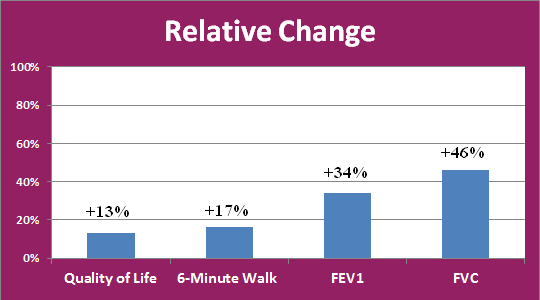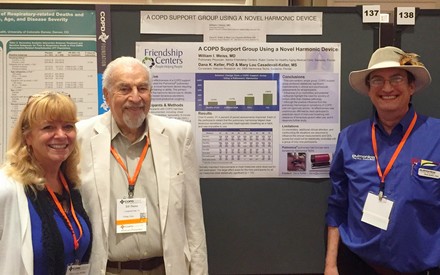The Pulmonica®
Research Results
From January through May 2013, a medically supervised study was conducted at the Senior Friendship Center in Sarasota, Florida, under the supervision of Dr. William Weiss, who has served as the pulmonologist at the Senior Friendship Center for 18 years. All study participants were tested for and had Stage 3 COPD (chronic obstructive pulmonary disease) without other serious comorbidity, such as CHF (congestive heart failure).
Nine COPD patients completed the pulmonary rehabilitation study, which included intake and exit interviews, spirometry, six-minute walk and quality of life assessments, educational programs on proper breathing techniques and use of medications, a brief exercise program using stretching, hand weights and chair exercises, and use of a novel harmonic device, the Pulmonica Pulmonary Harmonica. This device requires no musical talent, and participants were encouraged to simply breathe long, slow deep breaths in and out through the lowest holes they could manage comfortably. The lower holes provide a deep resonant sound that vibrates through the lungs and sinuses and is pleasant and meditative.
Results from the Medically Supervised Trial were extremely positive. All of the COPD patients improved in their quality of life assessment, spirometry, six minute walk, and everyone agreed that the more they played the Pulmonica, the better they breathed and felt.
COPD Study Quantitative Results
The quantitative results are shown in Table 1. The table shows the measure, baseline result, absolute change, p-value, upper and lower 95% confidence intervals, and relative change. All gathered data were used for the statistical results. Although the study was small in size, with more studies to come, the p-values statistics account for size.
| Measure (N=9) | Baseline Average | 8 Weeks Later* | Relative Change |
|---|---|---|---|
| Quality of Life Survey | 90 | 101 | +13% |
| 6-Minute Walk, feet | 383 | 447 | +17% |
| FEV1 | 40% | 54% | +34% |
| FVC | 42% | 61% | +46% |
| * All increases statistically significant at the p < .05 level. | |||
Graphically, the results are shown in Figure 1.

Clearly, participants benefited sufficiently from the overall respiratory therapy program that included clinical education, mild exercise, and use of the Pulmonica to warrant more detailed study and analysis. If you are a researcher interested in conducting research on the Pulmonica Pulmonary Harmonica, please leave a comment on our website and we will contact you.
COPD Study Qualitative Findings
The following qualitative findings were unanimous across study participants and are highly significant (p < .001).
- The more people played the Pulmonica – the better they could breathe
- The more people played the Pulmonica – the clearer their lungs were
- The more people played the Pulmonica – the more energy they had
- The more people played the Pulmonica – the better they felt
All participants felt that their overall wellness improved.
Testimonials included:

- Loosened fluids in lungs and sinuses, allowing people to cough up secretions and breathe easier
- Decreased rescue inhaler and nebulizer use
- Decreased auxiliary oxygen use
- Feeling calmer because of the meditative aspect of playing
- Better sleep
- Walking further
- Singing better
- Stronger talking voice
- Getting out again, such as to the beach and shopping
- Doing housework for themselves again
- Standing and walking without need of supports, such as walkers or canes
- Happier
- Joining a gym and riding a bike
- More hopeful about their future